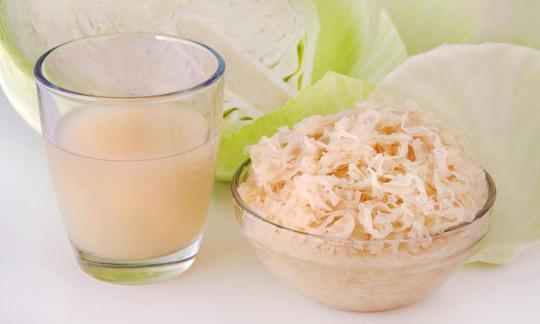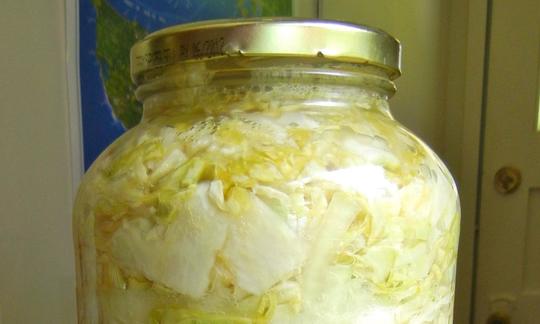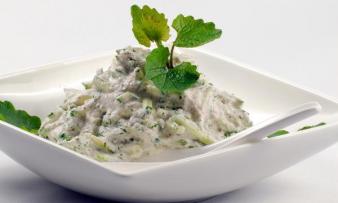Table of contents
Sauerkraut juice is a byproduct of sauerkraut production. There is evidence that organic sauerkraut juice contains more bioactive substances than conventional sauerkraut juice and that raw sauerkraut juice has more health benefits than heated sauerkraut juice.
Use in the kitchen
Sauerkraut juice tastes salty and spicy and has a mildly sour note. Small amounts of the juice are mainly drunk neat.
Sauerkraut juice is an excellent base for marinades, e.g. together with soy sauce, garlic and thyme for marinated carrots and tofu. Or mixed as a sauce with e.g. cashew nuts, hummus, tahini or vegan cream, for potatoes or raw vegetables.
Sauerkraut juice is also recommended as a salad dressing; pure or mixed with, for example, mustard, honey and olive oil or in tzatziki. Soups, sauces and stews benefit from the sour, hearty taste. For the more daring palates: Sauerkraut juice in small quantities also goes well in smoothies or vegetable juices.
Making your own sauerkraut juice
Making sauerkraut juice basically requires the same steps as making sauerkraut. Therefore, you can also find out about the production steps and explanations of the processes for the ingredient ' sauerkraut '.
2.5% salt seems to be optimal in terms of taste and food safety. Less salt is associated with a shorter shelf life and a greater risk of pathogens settling. 2
Ingredients (for 1 L juice): approx. 250 g white cabbage, 750 ml tap water, 25 g salt
Utensils: You will need a container suitable for fermentation processes. If you plan to ferment more foods using lactic acid fermentation in the future, we recommend purchasing so-called 'fermentation pots'. These traditional stone pots are specially designed for fermentation, are odorless and easy to clean. They are also suitable for preserving other vegetables such as cucumbers, beetroot and zucchini.
Procedure: Wash the white cabbage and remove any impure or damaged pieces. Finely chop the cabbage and knead it well with clean hands together with 6 g of salt. Press the pieces tightly into a suitable container and place a 'fermentation weight' on top so that the cabbage remains in the pressed state. The fewer air pockets in the cabbage, the better. Add 19 g of water mixed with it and make sure that the white cabbage is constantly covered. Close the container and let off the CO 2 gas that is produced in the first few days. The cabbage should now ferment for about a week at room temperature (around 21°). If you have a suitable place for this, place the cabbage somewhere cooler (approx. 15 °C) and let it ferment for another three weeks. Alternatively, you can leave the cabbage at room temperature for two weeks and then put it in the fridge. You can then simply strain the juice or use a juicer to process the sauerkraut into juice.
Sauerkraut juice recipe for vegan cream cheese made from macadamia nuts
Ingredients (for 6 people): 200 ml raw sauerkraut juice (organic or homemade), 350 g macadamia nuts, 2 tbsp yeast flakes, dried flowers.
Preparation: Put the macadamia nuts in a bowl, cover with tap water and leave to soak overnight. Sieve and drain the next day. Mix the nuts and sauerkraut juice and puree finely with a hand blender. Pour the mixture into a sieve lined with a kitchen towel, twist the towel over the mixture and weigh it down (e.g. with a bowl full of water). Press at room temperature for two days and leave to drain. Then mix the mixture remaining in the cloth with yeast flakes, press into any shape and place in the fridge overnight. Press the vegan cream cheese loaf out of the molds and garnish by rolling it in dried flowers.
Vegan recipes with sauerkraut juice can be found under the note: " Recipes that have the most of this ingredient ".
| Not only vegans or vegetarians should read this: Vegans often eat unhealthily. Avoidable nutritional errors. |
Purchasing - Storage
Sauerkraut juice is available all year round in many supermarkets (e.g. Migros, Spar, Aldi, Lidl, Rewe, Edeka, Hofer, Aldi, Billa), mostly not raw but pasteurized, but often organic. In other supermarkets (e.g. Coop, Denner, Volg) you will only find the juice sporadically or never. Organic supermarkets (e.g. Alnatura, Denn's Biomarkt), health food stores and also pharmacies and drugstores often have the healthy drink on offer and it is also organically produced. Raw sauerkraut juice is mainly found in online shops.
The availability of sauerkraut juice varies depending on the size of the store, catchment area, etc. Our recorded food prices for the DA-CH countries can be found above under the ingredient image - and by clicking you can see their development at various suppliers.
Storage tips
There are big differences between products. Pay attention to the manufacturer's recommendations and use your own senses. Storage in the refrigerator is recommended for raw sauerkraut or opened pasteurized sauerkraut juice.
Unfortunately, we were unable to find much information on storage during our research. A study showed that sauerkraut juice lost hardly any bioactive isothiocyanates after 13 weeks of storage. This suggests that sauerkraut juice still has positive health effects even after longer storage. Nevertheless, you should use the product quickly, as the good ingredients continuously decrease. 3
A good sauerkraut juice contains bacteriocins. These are substances secreted by bacteria that have an antimicrobial effect against food-contaminating bacteria and food-borne pathogens. 8
Ingredients - Nutritional values - Calories
Sauerkraut juice is extremely low in fat and calories - only 15 kcal and 0.2 g fat are contained in 100 g of the juice. The salt content is relatively high at 747 mg/100g - 100 g of sauerkraut juice provides 37% of the recommended daily maximum amount of sodium (294 mg/100g). 1 More sodium is usually found in highly processed foods such as toast with almost twice as much sodium (480 mg/100g) or even a pizza from the "fast food chain" can contain around 600 mg/100g sodium. 12
In addition to the rather high content of sodium chloride ( table salt), sauerkraut juice contains a significant amount of vitamin K. The content of 26 µg/100g (35% of the daily requirement) can be compared with that of celery (29 µg/100g) and miso (29 µg/100g). Significantly more vitamin K can be found in chard (830 µg/100g). 1
100 g of sauerkraut juice contains 264 mg of potassium - that's 13% of the daily requirement. Coconut milk (263 mg/100g) and pak choi (252 mg/100g) contain a similar amount of potassium. At 1,025 mg/100g, raw pistachios contain almost four times as much of the mineral. 1
Sauerkraut juice also contains vitamin C (8.2 mg/100g; 10% of the daily requirement). Carrot juice (8.5 mg/100g) and radicchio (8 mg/100g) contain a similar amount. Yellow bell peppers contain particularly high levels of vitamin C at 184 mg/100g. 1
The complete ingredients of sauerkraut juice, the coverage of the daily requirement and comparison values with other ingredients can be found in our nutrient tables. In the article Nutrients explained you will get a detailed insight into the topic.
Health effects
Is sauerkraut juice healthy? There are only a few studies on the health effects of sauerkraut juice. However, one effect stands out: sauerkraut juice has anti-cancer properties due to its high isocyanate content. The ascorbigen it contains, which can be converted into vitamin C and indole derivatives, also has anti-cancer properties. According to a study from 2021, sauerkraut juice can be classified as a 'functional food' - a food with positive effects on health - due to its effects and the bioactive substances it contains. 3,6 Another study pointed out the positive effect of sauerkraut juice on intestinal health. 19
How much sauerkraut juice can you drink per day? Since the natural probiotic ( raw sauerkraut only) or prebiotic ( pasteurized sauerkraut too) aids digestion and stimulates the appetite, you shouldn't drink too much of it; you should also keep an eye on the high sodium content. Since we couldn't find any studies on the optimal amount of sauerkraut juice and its effects, it is advisable to slowly work your way up to the amount of sauerkraut juice that suits you. It can also be helpful to get reports on sauerkraut from friends and acquaintances. This way you can prevent constipation, flatulence and digestive problems. You can find a more detailed description of the positive effects on the digestive tract under the ingredient ' sauerkraut, raw '.
Sauerkraut juice is a common recommendation for constipation. In fact, the lactic acid it contains is a well-known laxative. 9, 10
What effect does sauerkraut juice have on the body? Unfortunately, we were unable to find out exactly how sauerkraut juice works in the body. However, to get a rough idea, you can look at the effects of sauerkraut. There are more studies on this. So far, it has been observed that sauerkraut has antioxidant, anti-inflammatory and anti-cancer effects; as well as having a positive effect on the barrier function of the intestine, digestive tract, immune system and psyche. Details and literature on this can be found HERE.
When do you drink sauerkraut juice? In the morning, with dinner or just in recipes - whatever suits you best is often the best time to drink sauerkraut juice.
Secondary plant substances
Many of the health effects of sauerkraut or sauerkraut juice can be attributed to the secondary plant substances it contains. Our article on secondary plant substances provides an overview of the classification of substance groups, their occurrence in foods and possible effects on humans. Sauerkraut juice or raw sauerkraut contains the following secondary plant substances, among others: 3,4
Alkaloids: indole-3-carbinol, indole-3-acetonitrile, 3,3′-diindolylmethane
Organic sulphur-containing compounds: glucosinolates and their degradation products; isothiocyanates, nitriles
Other organic compounds: Ascorbigen
However, it should be noted that the composition of the secondary plant substances in sauerkraut juice can vary depending on the unprocessed cabbage (harvest time, variety, growing conditions) and preparation. Therefore, quantities are only of limited use and should only be understood roughly.
Dangers - Intolerances - Side effects
Does sauerkraut juice have side effects? Sauerkraut and sauerkraut juice tend to have high sodium levels due to the manufacturing process. Too much intake can have negative consequences for health, e.g. increased blood pressure and thus indirectly cardiovascular diseases. 13
Sauerkraut can contain certain substances that are problematic for health: biogenic amines, nitrites and pathogens. Histamines, putrescines and cadaverines are the most common biogenic amines in fermented vegetables. Poor hygiene or reusing the brine can lead to increased levels of biogenic amines. The (good) lactic acid bacteria can also produce biogenic amines, but below the toxic threshold. The recipe can also make a big difference. For example, fish sauce increases the likelihood of biogenic amines being produced; while onions lead to fewer. 14 In case of excessive consumption or general intolerance, symptoms such as nausea, difficulty breathing, hot flushes, sweating, palpitations, headaches, rashes, burning in the mouth and hypo- or hypertension can occur. 15,16
Nitrites can form nitrosamines, which can have a carcinogenic effect in the digestive tract. The formation of nitrites is also linked to the prevailing microbiome. Garlic appears to promote the growth of good bacteria. Bioactive additives, such as polyphenols from apple peel or the microelement selenium, can help keep the formation of nitrites in check. Certain lactic acid bacteria can also break down nitrite themselves. 14
Measures to avoid these substances are: hygiene, strict exclusion of oxygen, temperature between 15 and 24 °C, fresh high-quality ingredients, starter cultures and the right salt concentration.
Does sauerkraut juice cause diarrhea? The digestive juice acts as a gentle laxative. In large quantities it can cause diarrhea. Therefore, people who are prone to diarrhea should drink smaller amounts.
Folk medicine - natural healing
Does sauerkraut juice help against constipation? Sauerkraut drink is considered a tried and tested home remedy against constipation and other digestive problems.
Ecological footprint - animal welfare
The ecological footprint of white cabbage is generally small. The salt required can also be obtained from good sources and is part of a climate-friendly diet. A study by Greenpeace in collaboration with other cooperation partners calculated the CO 2 footprint of sauerkraut and came up with 0.5 kg CO 2 eq/kg; a small footprint comparable to raw vegetables. In relation to the macronutrients it contains, however, sauerkraut performs only slightly better than average foods and therefore does not contribute significantly to a climate-friendly diet. 17 Since sauerkraut juice is usually a by-product of sauerkraut production, sauerkraut juice could still be considered very climate-friendly. In the context of food waste, the production of naturally long-lasting and healthy foods such as sauerkraut and sauerkraut juice is a sensible strategy.
Based on publicly available data, Carboncloud calculated a theoretical CO 2 footprint of 1.66 kg CO 2 eq/kg sauerkraut. This discrepancy shows that the ecological footprint can vary depending on the method and data available. 18
Factors such as the origin of the cabbage, farming methods (organic vs. conventional), processing methods and packaging significantly influence the footprint. Therefore, it is understandable that there can be strong fluctuations in the ecological footprint of sauerkraut juice.
Unfortunately, we could not find any data on the water footprint of sauerkraut juice. However, this is an important indicator for the overall assessment of ecological sustainability.
For detailed explanations of various sustainability indicators (such as ecological footprint, CO2 footprint, water footprint), see our article: What does the ecological footprint mean?
Worldwide occurrence
Sauerkraut juice is consumed especially in Germany, Ukraine, Romania, Serbia and other regions on the Black Sea. 11
Lactic acid fermented cabbage, or sauerkraut, was eaten from the Roman Empire to the Himalayas. The history of Korean sauerkraut, kimchi, can be traced back about 3000 years. In the 18th century, sailors noticed that sauerkraut could prevent the serious deficiency disease scurvy. The cabbage kept long enough on the ship and provided enough vitamin C. 7 This is probably how sauerkraut and its juice spread to all corners of the world.
Industrial production
Sauerkraut juice is usually just a by-product of the production of sauerkraut or sometimes a direct pressed juice from sauerkraut. In most cases, the juice is then pasteurized. This kills the lactic acid bacteria. 20,21
The following lactic acid bacteria are involved in the process: Lactobacillus brevis, Lactobacillus sakei, Lactobacillus plantarum and Leuconostoc mesenteroides. 11
Further information
A study from 2017 found more bioactive substances ( secondary plant substances) in organically produced white cabbage and sauerkraut juice than in conventionally produced ones. This is probably related to the nitrogen supply or the fertilization strategy. 5
Since we tend to consume too much sodium, there are promising approaches to making sauerkraut with less than 2.5%. 22 However, when making your own, we recommend the tried and tested 2–2.5% salt.
Alternative names
Sauerkraut juice is sometimes called sauerkraut drink. In English it is called 'sauerkraut juice', 'kraut juice', 'pickled cabbage juice' or 'sauerkraut brine'.











Comments